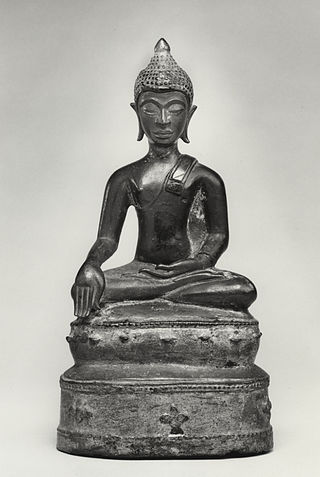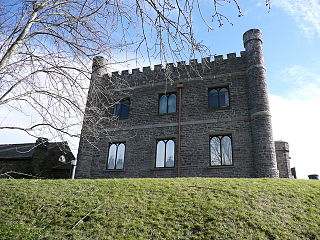
The Celts or Celtic peoples were a collection of Indo-European peoples in Europe and Anatolia, identified by their use of Celtic languages and other cultural similarities. Major Celtic groups included the Gauls; the Celtiberians and Gallaeci of Iberia; the Britons and Gaels of Britain and Ireland; the Boii; and the Galatians. The relation between ethnicity, language and culture in the Celtic world is unclear and debated; for example over the ways in which the Iron Age people of Britain and Ireland should be called Celts. In current scholarship, 'Celt' primarily refers to 'speakers of Celtic languages' rather than to a single ethnic group.
The Copper Age, also called the Chalcolithic or (A)eneolithic, is an archaeological period characterized by regular human manipulation of copper, but prior to the discovery of bronze alloys. Modern researchers consider the period as a subset of the broader Neolithic, but earlier scholars defined it as a transitional period between the Neolithic and the Bronze Age. It is also considered the first phase, of three, in the Metal Ages.

The La Tène culture was a European Iron Age culture. It developed and flourished during the late Iron Age, succeeding the early Iron Age Hallstatt culture without any definite cultural break, under considerable Mediterranean influence from the Greeks in pre-Roman Gaul, the Etruscans, and the Golasecca culture, but whose artistic style nevertheless did not depend on those Mediterranean influences.

The Red "Lady" of Paviland is an Upper Paleolithic partial male skeleton dyed in red ochre and buried in Wales 33,000 BP. The bones were discovered in 1823 by William Buckland in an archaeological dig at Goat's Hole Cave which is a limestone cave between Port Eynon and Rhossili on the Gower Peninsula, near Swansea in south Wales. Buckland believed the skeleton was a Roman era female. Later, William Solace examined Goat's Cave Paviland in 1912. There, Solace found flint arrow heads and tools and correctly concluded that the skeleton was in fact a male hunter-gatherer or warrior during the last Ice Age. Over the last 100 years, more advanced dating procedures have shifted the age from the Mesolithic period to the Palaeolithic era of the last Ice Age.

The Yetholm-type shield is a distinctive type of shield dating from 1200-800 BC. The known shields come from Britain and Ireland, excepting one from Denmark. Their modern name comes from Yetholm in southern Scotland where a peat bog yielded three examples. Twenty two examples are known, although some of these are fragmentary, and a further seven or eight are known from written sources but are lost today. The shields vary significantly in size, but are otherwise similar.

Llyn Cerrig Bach is a small lake located between Rhosneigr and Valley in the west of Anglesey, Wales.

Hafren Forest lies north-west of Llanidloes, an ancient market town in Mid Wales.

Prehistoric Wales in terms of human settlements covers the period from about 230,000 years ago, the date attributed to the earliest human remains found in what is now Wales, to the year AD 48 when the Roman army began a military campaign against one of the Welsh tribes. Traditionally, historians have believed that successive waves of immigrants brought different cultures into the area, largely replacing the previous inhabitants, with the last wave of immigrants being the Celts. However, studies of population genetics now suggest that this may not be true, and that immigration was on a smaller scale.

Arsenical bronze is an alloy in which arsenic, as opposed to or in addition to tin or other constituent metals, is combined with copper to make bronze. The use of arsenic with copper, either as the secondary constituent or with another component such as tin, results in a stronger final product and better casting behavior.

Llanwrthwl is a village and community in Powys, mid Wales, and the historic county of Brecknockshire. Llanwrthwl lies off the A470 road, north by road from Builth Wells and Newbridge-on-Wye and south of Rhayader. It lies on the River Wye and River Elan and the village is accessed by a bridge over the Wye. In 1833, its population was 517; its population in 1841 was 568; in 1845, its population was 563.

Bronze Age Britain is an era of British history that spanned from c. 2500–2000 BCE until c. 800 BCE. Lasting for approximately 1,700 years, it was preceded by the era of Neolithic Britain and was in turn followed by the period of Iron Age Britain. Being categorised as the Bronze Age, it was marked by the use of copper and then bronze by the prehistoric Britons, who used such metals to fashion tools. Great Britain in the Bronze Age also saw the widespread adoption of agriculture.

The Mold gold cape is a ceremonial cape of solid sheet-gold from Wales dating from about 1900–1600 BCE in the British Bronze Age. It was found at Bryn yr Ellyllon burial mound near Mold, Flintshire in 1833.
51.847288°N 4.318808°W The name Rhyd-y-gors or Rhydygors has been associated with two historic sites near the market town of Carmarthen in Southwest Wales. The first was the Norman Rhyd-y-gors Castle and the other was Rhyd-y-gors Mansion, home of the Edwardes family.

Abergavenny Museum is a museum situated in the grounds of Abergavenny Castle, Abergavenny, Monmouthshire, south east Wales.

The Banc Tynddol sun-disc is a small, decorated, gold ornament discovered at Cwmystwyth, Ceredigion, Wales. It most likely was part of a funerary garment and is more than 4,000 years old, which makes it the earliest gold artifact found in Wales. It was discovered on 16 October 2002 by a team of archaeologists who were investigating the site of Roman and medieval lead smelting hearths below the Bronze Age copper mine on Copa Hill.
Jennifer Foster is an English scholar of prehistoric and medieval archaeology, who specializes in the study of artifacts, particularly metalwork.

The archaeology of Wales is the study of human occupation within the country of Wales which has been occupied by modern humans since 225,000 BCE, with continuous occupation from 9,000 BCE. Analysis of the sites, artefacts and other archaeological data within Wales details its complex social landscape and evolution from Prehistoric times to the Industrial period. This study is undertaken by academic institutions, consultancies, charities as well as government organisations.

The Moel Hebog shield or Moel Siabod shield is a large copper-alloy Yetholm-type shield from Bronze Age Britain, found in Wales in 1784, and now in the British Museum in London. It dates from 1300–1000 BC.

Various artefacts originally found in or culturally important to Wales, are housed in museums outside the country, namely in England and France. Their housing outside of Wales has been controversial to some in Wales, calling for some artefacts to be repatriated (returned) back to Wales, while others argue Wales lacks the necessary museums and security for the artefacts to be housed in Wales safely.

Llyn Cerrig Bach Plaque is a bronze plaque that dates from 200BC to AD100 in the Iron Age, found at Llyn Cerrig Bach.















